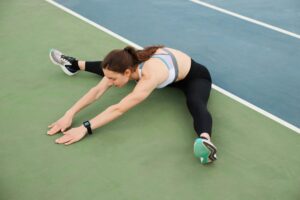From your thirties, you lose between 3 and 8% of your muscle mass every 10 years, and more after the age of 60. Bone mineral density also begins to decline in your 40s, putting you at risk for fractures and osteoporosis. Your VO2 max, or the ability of the heart and lungs to take in oxygen and convert it into energy, also decreases.
So, it is important to change a few of your habits early on so that you can slow down this decline:

1) The best way to be proactive about your future is to assess your physical fitness: the four key areas to check are your body’s strength, stability, mobility and cardiorespiratory fitness: which generally decline with age .
In this way I advise you to test your physical fitness which can therefore highlight your potential weaknesses or areas that need to be strengthened to prevent them from occurring.
For example, if your stability is fragile, start doing exercises to improve your balance, such as Tai Chi and Pilates. Also, if you are not very flexible, practice yoga or spend more time on dynamic stretching.
The best way to measure your cardiorespiratory fitness is to test your VO2 max with a doctor or exercise physiologist.
2) As you get older, you should primarily aim to get 150 minutes of exercise per week with moderate to vigorous intensity aerobic workouts and two strength training sessions (15 to 20 minutes per session), which together can increase both longevity and quality.
3) Variety is also good for heart health, especially blood pressure. Small changes can be beneficial. For example, if you usually do lunges, try overhead dumbbell presses. Another example, if you like to walk, once or twice a week, choose a more complicated route or walk as quickly as you can.

4) Prioritizing core muscles beyond the visible abs will also contribute to overall strength as we age. Planks are a great option, and pelvic floor exercises are also helpful.
5) Finally, to maximize profits, you need a progressive plan. You should continually increase the amount of weight you lift or the number of repetitions. It is important to challenge your body !
EUROPEAN PERSPECTIVE
Tips from fitness.fr
TRAINING: THE KEY TO GROWTH
To effectively stimulate your muscles and promote their growth, your training must be structured and progressive.
- Progressive overload: Gradually increase the intensity of your workout by adding weight, additional repetitions or advanced techniques. This allows you to continue to use your muscles and encourage their growth.
- Vary the exercises: Multi-joint exercises are essential for working several muscle groups at the same time. However, isolation exercises are also important for targeting specific muscles and correcting possible imbalances.
- Rest between sets: Rest time between sets is crucial to allow your muscles to partially recover and maintain the quality of your workout.
RECOVERY: THE TIME WHEN MUSCLES GROW
Proper recovery is essential for your muscles to repair and grow optimally.
- Sleep: Sleep is probably the most underrated aspect of recovery. Quality sleep promotes muscle growth and helps regulate key hormones, such as growth hormone.
- Post-Workout Nutrition: Consume a protein- and carbohydrate-rich meal or shake after your workout to boost the muscle recovery and repair process.
- Rest Days: Non-training days are necessary for full recovery. Take the opportunity to practice low-intensity activities like walking or yoga, which promote active recovery.
source: Fitness After 40: How You Should Change Your Workout – The New York Times & https://www.fitness.fr/comment-prendre-de-la-masse-musculaire-guide-pour-booster-vos-muscles/



